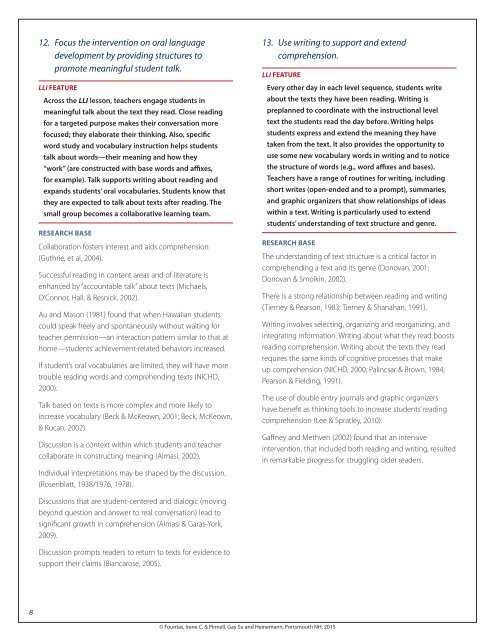Leveled Literacy Intervention
LLI_3_8_ResearchBase
LLI_3_8_ResearchBase
Create successful ePaper yourself
Turn your PDF publications into a flip-book with our unique Google optimized e-Paper software.
12. Focus the intervention on oral language<br />
development by providing structures to<br />
promote meaningful student talk.<br />
LLI FEATURE<br />
Across the LLI lesson, teachers engage students in<br />
meaningful talk about the text they read. Close reading<br />
for a targeted purpose makes their conversation more<br />
focused; they elaborate their thinking. Also, specific<br />
word study and vocabulary instruction helps students<br />
talk about words—their meaning and how they<br />
“work” (are constructed with base words and affixes,<br />
for example). Talk supports writing about reading and<br />
expands students’ oral vocabularies. Students know that<br />
they are expected to talk about texts after reading. The<br />
small group becomes a collaborative learning team.<br />
RESEARCH BASE<br />
Collaboration fosters interest and aids comprehension<br />
(Guthrie, et al, 2004).<br />
Successful reading in content areas and of literature is<br />
enhanced by “accountable talk” about texts (Michaels,<br />
O’Connor, Hall, & Resnick, 2002).<br />
Au and Mason (1981) found that when Hawaiian students<br />
could speak freely and spontaneously without waiting for<br />
teacher permission—an interaction pattern similar to that at<br />
home—students’ achievement-related behaviors increased.<br />
If student’s oral vocabularies are limited, they will have more<br />
trouble reading words and comprehending texts (NICHD,<br />
2000).<br />
Talk based on texts is more complex and more likely to<br />
increase vocabulary (Beck & McKeown, 2001; Beck, McKeown,<br />
& Kucan, 2002).<br />
Discussion is a context within which students and teacher<br />
collaborate in constructing meaning (Almasi, 2002).<br />
Individual interpretations may be shaped by the discussion.<br />
(Rosenblatt, 1938/1976, 1978).<br />
13. Use writing to support and extend<br />
comprehension.<br />
LLI FEATURE<br />
Every other day in each level sequence, students write<br />
about the texts they have been reading. Writing is<br />
preplanned to coordinate with the instructional level<br />
text the students read the day before. Writing helps<br />
students express and extend the meaning they have<br />
taken from the text. It also provides the opportunity to<br />
use some new vocabulary words in writing and to notice<br />
the structure of words (e.g., word affixes and bases).<br />
Teachers have a range of routines for writing, including<br />
short writes (open-ended and to a prompt), summaries,<br />
and graphic organizers that show relationships of ideas<br />
within a text. Writing is particularly used to extend<br />
students’ understanding of text structure and genre.<br />
RESEARCH BASE<br />
The understanding of text structure is a critical factor in<br />
comprehending a text and its genre (Donovan, 2001;<br />
Donovan & Smolkin, 2002).<br />
There is a strong relationship between reading and writing<br />
(Tierney & Pearson, 1983; Tierney & Shanahan, 1991).<br />
Writing involves selecting, organizing and reorganizing, and<br />
integrating information. Writing about what they read boosts<br />
reading comprehension. Writing about the texts they read<br />
requires the same kinds of cognitive processes that make<br />
up comprehension (NICHD, 2000; Palincsar & Brown, 1984;<br />
Pearson & Fielding, 1991).<br />
The use of double entry journals and graphic organizers<br />
have benefit as thinking tools to increase students’ reading<br />
comprehension (Lee & Spratley, 2010).<br />
Gaffney and Methven (2002) found that an intensive<br />
intervention, that included both reading and writing, resulted<br />
in remarkable progress for struggling older readers.<br />
Discussions that are student-centered and dialogic (moving<br />
beyond question and answer to real conversation) lead to<br />
significant growth in comprehension (Almasi & Garas-York,<br />
2009).<br />
Discussion prompts readers to return to texts for evidence to<br />
support their claims (Biancarose, 2005).<br />
8<br />
© Fountas, Irene C. & Pinnell, Gay Su and Heinemann, Portsmouth NH, 2015


